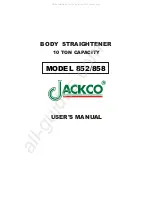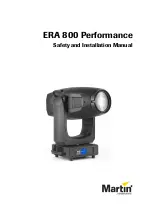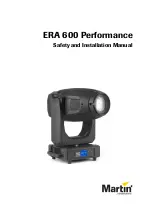
Section BXM‐10N‐HE3‐20A
030‐101741 Rev. B
R
12
1311IARB
1.
Attach one bracket and rod to top cabinet mounting bracket.
Thread a
washer and a nut about 1.5” onto one end of a rod (hereafter called “the short
end”). Abut the flat side of a kit bracket against the back of the cabinet's top
mounting bracket and align the mounting holes. Insert the short end of the
rod through the selected aligned holes.
Thread a washer, lock washer, then a
nut onto the protruding short end of
the rod from the front side
of the cabinet's mounting
bracket and tighten the
nut. Repeat with a second
rod at the other side of the
top mounting bracket.
2.
Attach lower bracket.
Repeat the step above
for the cabinet's bottom
mounting bracket and another
mounting bracket and rod from the
pole‐mount kit.
3.
Pre‐thread inner nuts for rear brackets.
Thread a nut and washer onto the
long end of each rod; stop threading when the nut appears to be about 1/4
of the distance into the pole depth (from the rear).
4.
Lift, level, and secure cabinet to pole.
Lift the cabinet to the desired
mounting height, straddle the pole with the protruding rods, press the cabi
net and the serrated edge of the attached brackets against the pole, and lev
el the cabinet. Hold the cabinet in place, and from behind the cabinet and
pole, hang another kit bracket from the top protruding rods, being careful to
select and align the holes correctly (select the same holes that were used
for the bracket attached to the cabinet) and also being sure to face the ser
rated edge of the kit's bracket toward the pole. Thread a washer, lock wash
er, and a nut onto each rod and alternately tighten each rod's nut firmly
against the bracket (so the lengths of the two rods left protruding are equal).
When tight, back‐thread the nuts previously threaded onto the rod (from
Step 3 above) backwards to abut the inside edge of the kit's rear mounting
bracket.
5.
Repeat above step for the lower, rear,
mounting bracket.
Figure 14. Pole Mount Kit (BXA‐PM02) Contents
Threaded
rod
Bracket
Washers and Nuts
BXA‐PM03 kit also
includes a shelf.
Figure 15. Boxer Mounted on Pole with Pole Mount Kit
Pole
Also see the instructions
in the optional BXA‐PM02
pole mount kit.
Also see the instructions
in the optional BXA‐PM02
pole mount kit.
4.
Route ground wire through knock‐out hole.
Run the ap
proved ground wire through the grommet or conduit to
the ground lug.
Figure 16. Ground Plate Location in Boxer Cabinet
Ground lug hardware should be
tightened to 20 inch-pounds
Ground
ESD jack
Plate
Ground
Lug
Earth
8 sets of posts for
bonding cables
and equipment
5.
Connect earth ground wire.
Connect the earth ground
wire to the #6 AWG ground lug on the ground plate, per
company practice.
6.
Seal the earth ground entrance hole.
Depending on the
type of fitting or grommet used, it may be necessary to seal
the ground wire entrance hole, as stated in the note below.
‐ NOTE ‐
To improve the integrity of the cable entries seal when rubber
grommets are used, a water‐proof foam or silicone sealant
should be used on the interior side of the cabinet, around the ex
posed grommet and cable entry.
7.
Ground installed equipment and cables.
As each cable and
piece of equipment is mounted inside the cabinet (in the
following sections), connect it to a ground lug or post pro
vided on the ground plate, per company practice.
8.
Use ESD ground jack.
Whenever installing equipment or
performing system testing or maintenance, use the pro
vided ESD ground jack also provided on the cabinet's
interior ground plate.
3.8
Making Fan Power Connections
To power the factory‐prewired Boxer cooling fans, an external
+24V (3.5A) or ‐48VDC (1.75A) power source must be con
nected to the power terminals of the Controller Card mounted
on the inside of the cabinet door.
‐ NOTE ‐
Ensure that the power source has sufficient power to support the
84 watts required to operate the Boxer fans plus the power re
quired for the telecommunications equipment that is being
installed in the cabinet.
Connecting ‐48VDC Fan Power
Follow the steps below to c24V or ‐48VDC fan power
to the Euro‐connector in the Controller Card in the Boxer cabi










































